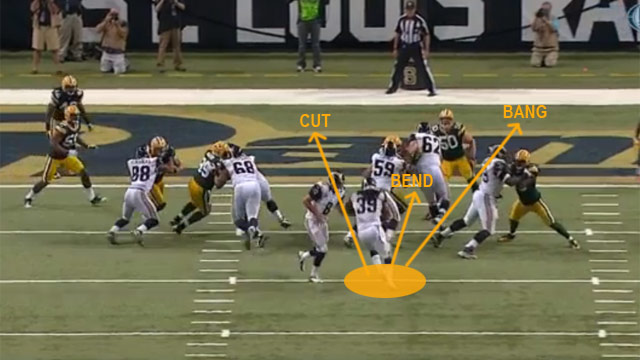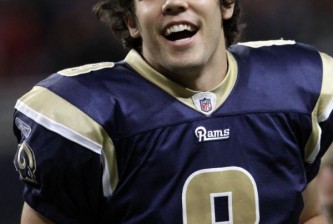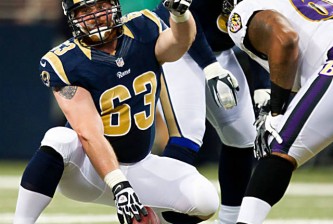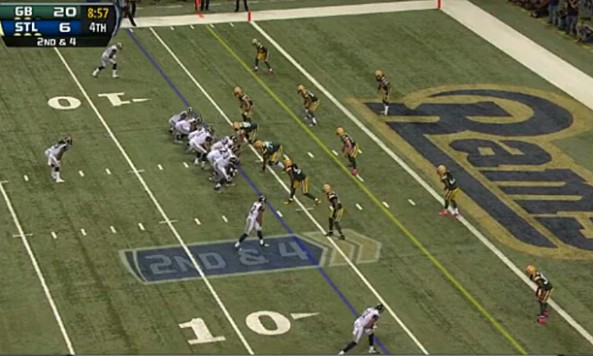
| Situation: | 2nd and 4 from the Packers 6, with 8:57 to play in the game, trailing by 14. |
| Personnel: | 11 |
| Play: | Double Left 20 Bubble |
| Defense: | Nickel, Cover 2 |
Pre-Snap
The Rams offense hasn't scored since the first half, and is in danger of falling out of this game completely. But a huge 56-yard catch-and-run play by Chris Givens puts the Rams just outside the red zone. Three runs and a short pass later, and the Rams have a second-and-goal, but the clock is working against them in a two-score game. They need to score decisively, and the defense has to get the ball back.
Offensive Play Call
The Rams come out in 11 personnel. Sam Bradford is under center with Steven Jackson 7 yards deep behind him. The “Double left” part of the call tells us Steve Smith (12) in the slot and Brandon Gibson (11) out wide to the field side. Smith’s split is a tighter split than normal. This allows Smith to block the overhang backer. Chris Givens (13) is lined up in the boundary. As is tight end, Lance Kendricks (88), who is on the line of scrimmage. The “20 Bubble” just tells that it is an inside zone run to the right. The 2 is an even number. The even numbers dictates that the play goes right (odd numbers to the left).
The Packers counter the Rams 11 personnel with their nickel package. Upfront, the Packers are in an even look (4 down linemen). Clay Mathews (52) is playing a 7-technique as a stand-up defensive end over Lance Kendricks. Nick Perry (53) is the stand-up defensive end over right tackle Barry Richardson (79) and is playing a wide-9 technique.
Inside, defensive tackle, Jerel Worthy (99), is aligned in a tight-3 technique, while nose tackle Ryan Pickett (79) is in a 2-I look. A tight-3 means that Worthy is on the outside shoulder of the guard. Instead Worthy’s hand being in the hole (just a normal 3-technique) his hand is just inside of Shelley Smith’s outside leg. Pickett’s 2-i technique means he is going to line up on the inside eye of Harvey Dahl.
Packers have two linebackers in the box. Linebacker Brad Jones (59) is stacked over Lance Kendricks. AJ Hawk (50) is playing lined up in the playside B-gap. Behind Jones and Hawk are two-high safeties look. It’s a unique call. The two-high safety look is not the best play call to stop the run. Since the Rams are on the Packers 6 yard line, to me, this look shows what the Packers thought of the Rams Red Zone ground game. And how can you blame them, to this point the Rams were yet to score a rushing touchdown.
The Play
What Happens After the Snap

Offensive Line: Robert Turner and Harvey Dahl (Front-side)
You may recall in the Daryl Richardson article, in a zone blocking scheme, the offensive line works in together in calls ranging from two-man calls, three-man calls, and four-man calls. A zone blocking scheme differs from a man blocking scheme in that at the snap of the ball, the offensive linemen isn’t responsible for one man, but for men. How many men the linemen are responsible for depends on how many offensive linemen are in a call.
Here, Turner and Dahl are working together in a two-man call and therefore responsible for two defenders. Teams will use different verbiage to make this call, but a basic way to make this call is “COG” (C= Center, G=Guard). In two-man zone blocking scheme, the pairing will be responsible for a defender at the first level (defensive line) and at the second level (linebacker). Given the Packers alignment on this play, Turner and Dahl are responsible for nose tackle, Ryan Pickett, and front-side linebacker, AJ Hawk.
At the snap, Turner and Dahl will double team nose tackle Ryan Pickett. On this particular double team, it’s imperative that the pair use a “three hands on / four eyes on” approach. The “three hands on” refers to how many hands go on the defensive linemen. Turner has both hands on. Dahl has one hand on, his inside hand. The hand on is referred to as a post hand. Dahl will shoot his inside hand to the nearest armpit, posting up Pickett. Dahl keeps his outside arm free so that he come off if his linebacker fills the gap fast. Committing the outside hand would force Dahl to flip his hips which essentially makes his pending block on AJ Hawk a lot tougher. Ideally after the snap, Dahl’s post hand stops Pickett from running the line, pinning Pickett inside. During such time, Turner is working to cover up Pickett and begin driving him up field. Once Dahl feels Turner presence, he climbs to the second level to block AJ Hawk. Turner does a good job covering up Pickett. Covering up refers to the shade Turner uses to block Pickett. Turner wants to stay square, working chest to chest, and shoot his hands to Pickett’s armpits. This gives Steven Jackson a two-way go.
“The four eyes on” references how many eyes Turner and Dahl have on the linebacker. This goes back to the notion above that Turner and Dahl are responsible for a man at the snap of the ball but rather two men. If for instance, Pickett were to slant outside and AJ Hawk would have inside leverage on Dahl, Turner would shove Pickett outside and eventually would climb up to AJ Hawk. The “three hands on / four eyes on” approach allows for the pairing to adjust on the fly.
Offensive Line: Shelley Smith and Joe Barksdale (Backside)
Like the pairing of Turner and Dahl, Smith and Barksdale are working in a two-man call. Again, teams will have different verbiage for this call, but a basic call is an “DEUCE” call (backside guard and tackle working up to the linebacker). Also like Turner and Dahl, the Smith and Barksdale pairing will be responsible for a first-level defender and a second-level defender. Here, it is linemen, Jerel Worthy and backside linebacker, (sometimes referred to as the minus linebacker in a zone scheme). Brad Jones.
Their technique is very similar to that of Turner and Dahl in that Smith and Barksdale will use the “three hands on / four eyes on approach”. The back part of this double team, Barksdale, will have what’s known as a reach block. A reach technique is when a blocker is working to the defenders outside shoulder (or here Worthy’s inside shoulder) to prevent the defender from being able to run the line of scrimmage. So where Turner worked to square on Pickett to give Jackson a two-way go, Barksdale will work to the outside shade of Worthy to seal the hole. And where Turner shot his hands to the armpits, Barksdale wants to shoot his left hand to Worthy’s sternum. This punch to the sternum should slow down Worthy’s up field penetration. Barksdale wants to shoot his right hand to Worthy’s left shoulder pad. He will begin to throw that shoulder pad to the sky. This punch is to prevent Worthy from further running the line.
Lastly what Barksdale wants to do is get his hips around to finish this reach block. Because the considerable leverage Smith and Barksdale have on linebacker, Brad Jones, Smith can afford to be very patient on this double team. Smith will go thick up through Worthy to Jones. “Thick” refers to how much contact on Worthy, Smith will have. Smith doesn’t have to climb up to Jones until he feels Jones is a threat to make the play. This in turn allows more time for Barksdale to work his hips around to complete his reach block. Smith does a very good job at being patient and controlling Worthy and allowing Barksdale to get his hips around. Barksdale is able to get his hips around on Worthy, cutting off Worthy’s ability to run the line. This creates another option for Steven Jackson to run through.

Steven Jackson
The reason why the zone is such a great play is that the running back can always make the offensive line right. As long as the offensive line covers up the defenders and does not allow any penetration (penetration kills zone) the running back will have options. The zone scheme presents the running back with three options: bang, bend, bounce. However, typically inside zones eliminates the bounce option and substitutes it with a cut option.
The bang option is the original hole. Here that is between Dahl and right tackle Barry Richardson. Off the snap, Jackson will take a zone step to the playside, pointing his toe to the outside hip of Dahl. The step and subsequent toe pointing opens Jackson’s hips. If you notice, Dahl and Jackson’s steps are identical. Jackson is reading colors. Jackson’s first read is to the outside shade of Dahl. When Jackson reaches the mesh point (point where he receives the handoff from the quarterback) Hawk has outside leverage on Dahl. Additionally, I assume prior to the snap Jackson saw the Packers were in a two-high safety look which means had Jackson choose this path and made it past AJ Hawk, there was no one to block safety, Jerron McMillian. Conversely, the two-high safety look lets Jackson know the middle of the field is open.
The bend option is the first hole backside of the original hole. This option is the hole between Dahl and Turner. This hole never really appears. Pickett’s 2-i shade prior to the snap prevents this hole from opening.
The cut option is the second hole backside of the original hole. This option is the hole between Turner and Smith. Because of the job Smith and Barksdale do on Jerel Worthy and the fact the Packers leave the middle of the field open with their two-high safety look this option appears to be Jackson’s best path. Even though Jackson will enter a hole two spots down from his original path, because of the way zone is designed, Jackson’s cut is actually very minimal. This is because Pickett’s lateral movement makes what would have been the bend option the cut option without requiring Jackson to really do anything. Which brings me back to my original point, if the offensive line covers up defenders and prevents penetration, the running back will always make the offensive line right.
All that is left to do now is finish the run. In every run play, there will always be a defender that is unaccounted for. This defender must be beat by the running back. Here, because of the teams respective alignments, there are two players unaccounted for, safeties Morgan Burnett and Jerron McMillian. Jackson does a nice job of lowering the pad level and finishing the run. Although, it’s probably safe to say, neither of those guys wanted to get in the way of that train.
Result
A simple play – yes. But significant in the fact that it was the first rushing touchdown for a Rams running back this season. It took nearly 27 and a half quarters, but it happened. The Rams have really struggled inside the Red Zone. Their Red Zone touchdown scoring percentage is at 41.2% which puts the Rams in the bottom 5 in the league. For comparison, the Packers are ranked number 1 in this category at 76.2%.
Additionally, the Rams average 1.0 Red zone Touchdowns a game which also puts the Rams in the bottom 5 in the league. Certainly there a few factors that have contributed to the Rams lack of success in the Red Zone (e.g. lack of a real Red Zone target, dumb penalties). However, the biggest contributor to the Rams lack of success in the Red Zone is their inability to run the ball down there. Moving forward, the Rams will have to do a better job running the ball in the Red Zone. This touchdown is a step in the right direction.























